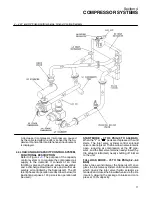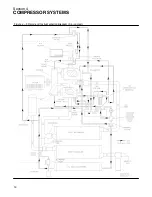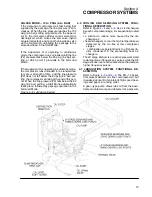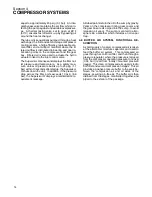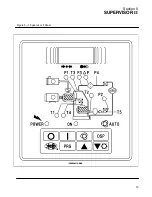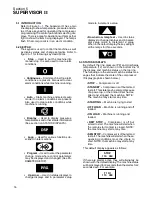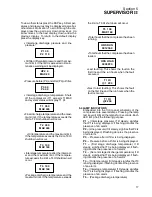
Section 1
SAFETY
2
C. DO NOT
permit fluids, including air line anti---
icer system antifreeze compound or fluid film to ac-
cumulate on, under, or around acoustical material,
or on any external surfaces of the air compressor or
on internal surfaces of the enclosure. Wipe down
using an aqueous industrial cleaner or steam clean
as required. If necessary, remove acoustical mate-
rial, clean all surfaces and then replace acoustical
material. Any acoustical material with a protective
covering that has been torn or punctured should be
replaced immediately to prevent accumulation of
liquids or fluid film within the material
. DO NOT
use
flammable solvents for cleaning purposes.
D.
Disconnect and lock out all power at source prior
to attempting any repairs or cleaning of the com-
pressor or of the inside of the enclosure, if any.
E.
Keep electrical wiring, including all terminals and
pressure connectors in good condition. Replace
any wiring that has cracked, cut, abraded or other-
wise degraded insulation, or terminals that are
worn, discolored or corroded. Keep all terminals
and pressure connectors clean and tight.
F.
Keep grounded and/or conductive objects such
as tools away from exposed live electrical parts
such as terminals to avoid arcing which might
serve as a source of ignition.
G.
Remove any acoustical material or other mate-
rial that may be damaged by heat or that may sup-
port combustion and is in close proximity, prior to
attempting weld repairs.
H.
Keep suitable fully charged Class BC or ABC fire
extinguisher or extinguishers nearby when servic-
ing and operating the compressor.
I.
Keep oily rags, trash, leaves, litter or other com-
bustibles out of and away from the compressor.
J. DO NOT
operate the compressor without proper
flow of cooling air or water or with inadequate flow
of lubricant or with degraded lubricant.
K. DO NOT
attempt to operate the compressor in
any classification of hazardous environment unless
the compressor has been specially designed and
manufactured for that duty.
1.5 MOVING PARTS
A.
Keep hands, arms and other parts of the body
and also clothing away from couplings, fans and
other moving parts.
B. DO NOT
attempt to operate the compressor
with the fan, coupling or other guards removed.
C.
Wear snug fitting clothing and confine long hair
when working around this compressor, especially
when exposed to hot or moving parts.
D.
Keep access doors, if any, closed except when
making repairs or adjustments.
E.
Make sure all personnel are out of and/or clear of
the compressor prior to attempting to start or oper-
ate it.
F.
Disconnect and lock out all power at source and
verify at the compressor that all circuits are de---en-
ergized to minimize the possibility of accidental
start---up, or operation, prior to attempting repairs
or adjustments. This is especially important when
compressors are remotely controlled.
G.
Keep hands, feet, floors, controls and walking
surfaces clean and free of fluid, water or other liq-
uids to minimize the possibility of slips and falls.
1.6 HOT SURFACES, SHARP EDGES AND SHARP
CORNERS
A.
Avoid bodily contact with hot fluid, hot coolant,
hot surfaces and sharp edges and corners.
B.
Keep all parts of the body away from all points of
air discharge.
C.
Wear personal protective equipment including
gloves and head covering when working in, on or
around the compressor.
D.
Keep a first aid kit handy. Seek medical assis-
tance promptly in case of injury.
DO NOT
ignore
small cuts and burns as they may lead to infection.
1.7 TOXIC AND IRRITATING SUBSTANCES
A. DO NOT
use air from this compressor for respi-
ration (breathing) except in full compliance with
OSHA Standards 29 CFR 1910 and/or any applica-
ble Federal, State or Local codes or regulations.
DANGER
!
Death or serious injury can result from inhaling
compressed air without using proper safety
equipment. See OSHA standards and/or any ap-
plicable Federal, State, and Local codes, stan-
dards and regulations on safety equipment.
B. DO NOT
use air line anti---icer systems in air
lines supplying respirators or other breathing air
utilization equipment and
DO NOT
discharge air
from these systems in unventilated or other con-
fined areas.
C.
Operate the compressor only in open or ade-
quately ventilated areas.
D.
Locate the compressor or provide a remote inlet
so that it is not likely to ingest exhaust fumes or
other toxic, noxious or corrosive fumes or sub-
stances.
E.
Coolants and lubricants used in this compressor
are typical of the industry. Care should be taken to
avoid accidental ingestion and/or skin contact. In
the event of ingestion, seek medical treatment
promptly. Wash with soap and water in the event of
skin contact. Consult Material Safety Data Sheet for
information pertaining to fluid of fill.
Summary of Contents for DR-13 Series
Page 6: ...NOTES ...
Page 14: ...8 NOTES ...
Page 18: ...Section 4 COMPRESSOR SYSTEMS 12 Figure 4 5 Piping and Instrumentation Diagram Air cooled ...
Page 21: ...Section 5 SUPERVISOR II 15 Figure 5 1 Supervisor II Panel ...
Page 28: ...22 NOTES ...
Page 32: ...26 NOTES ...
Page 42: ...Section 7 MAINTENANCE 36 Table 1 Installation Data ...
Page 46: ...40 NOTES ...
Page 48: ...Section 9 ILLUSTRATIONS AND PARTS LIST 42 9 3 COMPRESSOR MOTOR AND FRAME ...
Page 50: ...Section 9 ILLUSTRATIONS AND PARTS LIST 44 9 4 AIR INLET SYSTEM ...
Page 52: ...Section 9 ILLUSTRATIONS AND PARTS LIST 46 9 5 COOLER ASSEMBLY ...
Page 54: ...Section 9 ILLUSTRATIONS AND PARTS LIST 48 9 6 LP HOT LP COLD ...
Page 56: ...Section 9 ILLUSTRATIONS AND PARTS LIST 50 9 7 HP DISCHARGE ...
Page 58: ...Section 9 ILLUSTRATIONS AND PARTS LIST 52 9 8 LUBE SYSTEM ...
Page 60: ...Section 9 ILLUSTRATIONS AND PARTS LIST 54 9 9 ELECTRICAL BOX ...
Page 62: ...Section 9 ILLUSTRATIONS AND PARTS LIST 56 9 10 CONTROL SYSTEM CONDENSATE DRAIN ...
Page 64: ...Section 9 ILLUSTRATIONS AND PARTS LIST 58 9 11 CANOPY ...
Page 66: ...Section 9 ILLUSTRATIONS AND PARTS LIST 60 9 12 DECALS ...
Page 68: ...Section 9 ILLUSTRATIONS AND PARTS LIST 62 9 12 DECALS ...
Page 70: ...Section 9 ILLUSTRATIONS AND PARTS LIST 64 9 12 DECALS ...
Page 72: ...Section 9 ILLUSTRATIONS AND PARTS LIST 66 9 13 DECAL LOCATIONS ...
Page 74: ...Section 9 ILLUSTRATIONS AND PARTS LIST 68 9 13 DECAL LOCATIONS ...
Page 76: ...Section 9 ILLUSTRATIONS AND PARTS LIST 70 9 13 DECAL LOCATIONS ...
Page 78: ...Section 9 ILLUSTRATIONS AND PARTS LIST 72 9 14 WIRING DIAGRAM ...
Page 79: ...NOTES ...

















